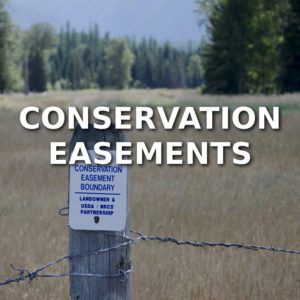Conservation Easements

What is a Conservation Easement?
A conservation easement is a legal agreement between a landowner and a land trust that limits the uses of the land in order to protect its conservation values. The landowner retains title to the property. The creation of the conservation easement can qualify as a one-time donation that has tax benefits. The conservation easement runs with the title, meaning that if the property is purchased by a new owner, the conservation easement remains.
Land ownership carries with it a bundle of rights—the right to occupy, lease, sell, develop, construct buildings, farm, restrict access or harvest timber, among others. A landowner can give up one or more of those rights for a purpose such as conservation while retaining ownership of the remainder of the rights. In ceding a right, the landowner “eases” it to another entity, such as a land trust. For example, a landowner may give up the right to build additional structures while retaining the right to grow crops.
Landowners looking to sell their property can use conservation easements to protect what future owners are able to do with the property. This typically reduces the marketable value of the property. If the conservation is setup properly, the landowners are able to take advantage of tax benefits associated with the creation and “donation” of the conservation easement.
The potential tax benefits of a donated conservation easement are two-fold. First, income tax benefits may exist at the federal level. There may be benefits at the state level as well. However, state property taxes can not be reduced by a donation of a conservation easement in Montana. Second, the conservation easement works as an estate planning tool to reduce estate tax liability.
To qualify for a tax deduction, the donation of a conservation easement must be considered a charitable gift by the IRS(Internal Revenue Service). It is strongly recommended that a qualified tax professional review the conservation easement donation to ensure it meets IRS requirements. A tax deductible, charitable donation can only be made to an IRS qualified tax-exempt organization. The donation of a conservation easement must be complete and irrevocable in perpetuity.
In order to claim a tax deduction on the donation of a conservation easement the landowner must obtain a qualified appraisal by a state certified appraiser.
Conservation Easement FAQ(Frequently Asked Questions)
Q) How much is a conservation easement worth?
A) This needs to be determined by a qualified appraiser based on the uses of the land.
Q) How long does it take to put a Conservation Easement In Place?
A) It typically takes from three to nine months to complete the paperwork for a conservation easement.
Q) Do Conservation Easements reduce Montana Property Taxes?
A) No, by Montana statute property taxes cannot be reduced by donation of a conservation easement.
Q) Can the property still be sold with a Conservation Easement in Place?
A) Yes, the landowner retains full ownership of the land and if they sell it the property is sold with the conservation easement attached(it travels with the land). The new landowner is subject to the same restrictions as the landowner who created the easement.
Q) Do you have to grant public access to the land as a condition of the conservation easement?
A) No, conservation easements do not require that public access to the land be granted.
Category : Ranch Articles

